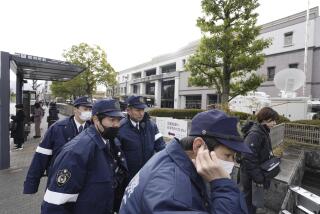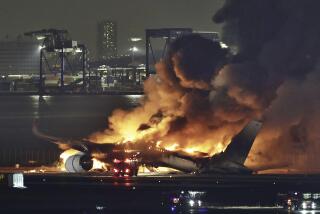Two die as man sets himself on fire aboard Japanese bullet train
Reporting from Tokyo — Two people died on a Japanese bullet train traveling from Tokyo to Osaka on Tuesday when a 70-year-old man poured a flammable liquid over his body and set himself on fire in the first carriage of the train. A woman in her 50s was found dead from smoke inhalation at the end of the car, and several people were injured, according to the government and local media reports.
Roughly 1,000 people were on board, and two passengers’ injuries were serious. An unknown number of others suffered from smoke inhalation and other injuries.
Japan’s Shinkansen bullet trains have a strong safety record, and no one has been killed in a crash in their half-century of operation. But Tuesday’s incident was a reminder that passengers are vulnerable to the unpredictable behavior of fellow riders. The incident created a huge stir in Japan, where the Shinkansen is generally regarded as supremely safe.
The Nozomi Shinkansen Express train was between the Shin-Yokohama and Odawara stations when a passenger in the first car activated the emergency alarm at 11:30 a.m. The driver brought the train to a halt. Passengers uploaded photos to social media sites of the train filled with bluish-gray smoke. All trains on the line were stopped temporarily.
NHK, the national broadcaster, quoted a woman in her 60s who said she encountered the man shortly before he set himself on fire.
“The man came to my seat and said, ‘I just picked this money up, so you can have it,’ and put several 1,000-yen bills on the seat-back table. ‘I don’t need it,’ I told him, and the man started walking aimlessly down the aisle, pouring on himself what looked like oil,” she said. “I told him to stop, and he said, ‘You’re in danger, too, so please escape,’ and I ran to the back of the train. In that time, the man set himself on fire.”
The Shinkansen train network is the connective tissue of the country, running through most major cities in Japan. The network operates with great punctuality, serving almost 400,000 passengers daily. Prime Minister Shinzo Abe set up a task force to respond to the incident, his office said. Within a few hours, trains were running on more or less their normal schedule.
It was not clear why the man set himself on fire. No suicide note has been found, authorities said. The man was not publicly identified.
Japan has a high suicide rate, and train stations have taken numerous preventive measures to discourage people from jumping in front of trains. But self-immolations are rare in Japan.
However, in June 2014, a former taxi driver set himself on fire across from Tokyo’s Shinjuku station in protest of Abe’s proposal to revise the constitution and expand the powers of Japan’s self-defense forces; he survived. And last November, a man set himself on fire in Tokyo’s Hibiya Park, close to many government buildings. Before his death, he sent a note of protest to the government and the media, demanding that Abe and the government cease their plans for new security laws.
While there has never been a Shinkansen crash, there have been several violent incidents related to the train. In August 1993, a 27-year-old man high on methamphetamines riding the Shinkansen fatally stabbed a businessman and seriously injured a police officer. In February 1995, there was an attempted murder on the Tokaido Shinkansen.
In 1998, bullets were fired in a restroom of the Nagano Shinkansen. And in 2002, shots were fired at the train. In both cases, there were no injuries.
There have been other suicides on the bullet trains, including one in 2007 and another in February 2009; in that case, a man managed to pry open the doors of a train running 120 mph and jumped to his death. The year 2008 was marked by a series of attempted suicides and people toying with the doors, causing the trains to make emergency stops.
Louis Krauss contributed to this report. Adelstein is a special correspondent.
More to Read
Sign up for Essential California
The most important California stories and recommendations in your inbox every morning.
You may occasionally receive promotional content from the Los Angeles Times.










